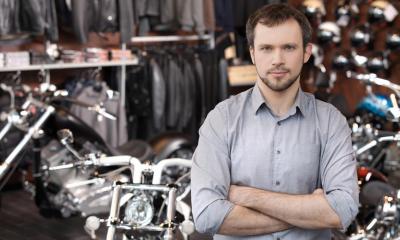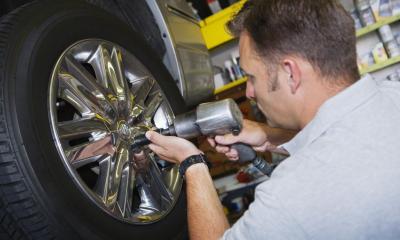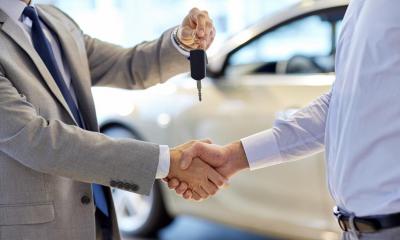
You'll need plenty of working capital if you want to sell new motorcycles, so many dealers choose to only sell second-hand machines. Read our in-depth practical guide to starting up and running your own motorcycle retailing business.
- Research your target market
- Decide what motorcycles and accessories you will sell
- Price your services
- Sell in-store finance
- Buy an existing motorcycle business
Research your target market
Estimate demand
You will need to find out whether there is enough local demand for your proposed motorcycle dealership.
The use of motorcycles rose in 2020 and 2021. This can be partly attributed to the pandemic, which made socially-distanced travel a necessity, and the boom in delivery services. The Motorcycle Industry Association (MCIA) publishes up to date figures for new motorcycle registrations by style and by engine size. You may find it useful to study these before deciding what to stock.
Make a thorough survey of the outlets selling motorcycles in your area and decide whether you can compete. Try to establish:
- what makes and models they sell and the prices they charge
- whether they offer servicing, repairs and MOT testing
- if they hire out motorcycles and offer any other services like Compulsory Basic Training (CBT) courses
- how knowledgeable and helpful their staff are
- whether the premises and fittings are modern and smart and whether they also sell online
Smaller machines, particularly those made in China, are increasingly sold by online-only retailers - either through their own websites or through a third-party website like eBay. So check out the online competition as well.
Why will customers choose your shop?
You need to make sure that enough customers will choose your shop rather than existing outlets. Your market research might indicate that there is a gap in the market that your shop can fill. You may, for example, decide to stock an unusual make of machine or to target buyers of off-road motorcycles.
Establish your customer profiles
You will probably find that a large percentage of your customers are young men (typically under 30) - this group is traditionally the most important to the motorcycle retailing sector. You may find that you also make significant sales to men over 40. Women account for only between 10% and 15% of active riders in the UK according to the Motor Cycle Industry Association.
As a general rule of thumb, due to licence restrictions and insurance costs young riders tend to buy smaller machines. Older ones buy more powerful ones, unless the machine being purchased is to be used exclusively for commuting - in which case smaller, more economical models are typically chosen.
If you sell to the trade, your customers are likely to include rider training schools and possibly race teams.
The Driver and Vehicle Standards Agency issue new moped and motorcycle rules setting out the age and qualification requirements for riding different types of motorcycles. There are easy-to-use flowcharts that set out these rules available on the GOV.UK website.
Check out future developments
The location of your outlet is crucial. Ideally, there will be ample and easy parking nearby and plenty of passing trade. Check that there are no plans to build new road systems, which would mean that traffic would bypass your shop, nor proposals to impose parking restrictions. If possible, check whether a direct competitor is in the process of opening in your proposed location.
Research current trends, plus legal and tax issues
- Sector trends for motorcycle dealers
- Legal issues for motorcycle dealers
- VAT rules concerning motorcycle dealers
Decide what motorcycles and accessories you will sell
There is a wide variety of items and services that you may decide to offer. Depending on the focus of your business, you may choose to offer some or all of the following:
- new motorcycles, mopeds and scooters
- second-hand and ex-demonstrator machines
- damaged repairable machines and salvage (insurance write-offs)
- new and used spare parts
- bolt-on customising accessories and engine tuning parts
- helmets, boots and protective clothing, including leathers and waterproofs
- consumables, including oils and other fluids
- small accessories, novelty items and sundries
- casual and fashion clothing
- manuals and specialist magazines
- servicing, repairs and MOT tests. (Note that in Northern Ireland, MOT testing is done by the Driver and Vehicle Agency and can't be carried out by private businesses)
- motorcycle hire
- rider training
You might also earn commission on the sale of:
- finance
- extended warranties
- insurance
- personalised number plates
As well as selling from your retail premises, you might also decide to sell online through your own website and/or an online marketplace like eBay or through your own mail order service. An ecommerce website allows you to sell online to a wider audience and potentially beyond the UK.
Advertising your shop
Whatever the nature of your shop, make sure that your potential customers know that your shop exists and the products and services it offers.
There are a number of things you can do to promote your business:
- create your own website, showing details of the motorcycles and accessories that you sell and the services that you offer
- set up a Google Business Profile so that you appear in search results for motorcycles in your area
- form links with rider training businesses to offer, for example, a free or discounted CBT course with the purchase of a new learner machine
- sponsor a local event or race team
Price your services
Make sure that the difference between the cost price and the selling price of the motorcycles and other items that you sell is enough to cover all of your operating costs, including your own drawings. You may have to price in line with your immediate competitors, unless you are targeting a niche market that your competitors don't cater for or are in the happy position of being largely unopposed - perhaps because you are the only dealer in your area that sells a particular motorcycle brand that has a strong following.
Motorcycle magazines print features on different motorcycles and accessories and give details of price and performance. All the major manufacturers' websites give details of each of their models, including the RRP. This means most customers will have a very good idea what price items should be and will go elsewhere, or buy online, if you cannot match that price.
With used machines, you may have more leeway on pricing. But many customers will look at a range of classified ads beforehand, so you'll need to make sure that your prices are broadly in line with those set by private and trade sellers - at least for bikes that are widely available.
Clothing and accessory suppliers may suggest retail prices in their catalogues and price lists. You may find that these are too high when compared with the competition, so you need to offer discounts to make sufficient sales.
Special offers and discounts
You may offer a discount as a matter of course to any trade customers you have. How much discount will depend on your pricing policy and how much local competition there is. You could offer further discounts for buying goods in large quantities.
Discounts may also be used as a way of boosting sales when trade is slow, or to shift last season's stock.
Sell in-store finance
A motorcycle can be a large, expensive purchase. Some customers may prefer to spread the cost over several months.
You can offer credit to these customers through a specialist finance company. Such companies offer a range of different in-store finance packages for retailers, such as:
- card-based credit accounts
- standard interest-bearing credit
- subsidised interest rate credit
- interest-free credit
- deferred payment (buy now pay later) credit
When you sell something on finance you will have to fill in a credit application with the customer. Your finance company will then give a decision on whether to accept the application. All being well, the transaction will be completed quite quickly, and you will receive payment for the goods from the finance company within a few days. You will usually also be paid a commission. This is normally based on a percentage of the value of the sale and paid to you separately at the end of the month.
Most finance companies will expect you to meet certain requirements and standards before agreeing to do business with you. Some will only deal with businesses that have been trading for a minimum length of time, often two years.
Shop around to choose a finance company, as their terms and working practices vary.
Consider:
- what type of finance packages are most likely to appeal to your customers
- how promptly will you receive payment from the finance company
- how much commission are you offered
- how quickly your customers' credit applications will be turned around
- what level of support is available to you
You will need consumer credit authorisation if you want to offer finance to your customers. This is obtained from the Financial Conduct Authority (FCA). You can get more guidance on the FCA website.
Buy an existing motorcycle business
You might decide to buy an existing motorcycle dealership rather than start your own venture from scratch. Buying a going concern can mean that the products, customers, regular sales, staff, premises and equipment are already in place.
But buying a business can be a hazardous, expensive process unless you have the right skills and experience on your team, including legal and financial know-how. Establish the genuine trading and financial position, so that the price you pay for the business is not too high.
- What is the age, condition and current 'book' value of any stock of motorcycles you are buying?
- If the business you are buying holds a franchise from a motorcycle manufacturer, check whether this can be transferred to you when you take over.


